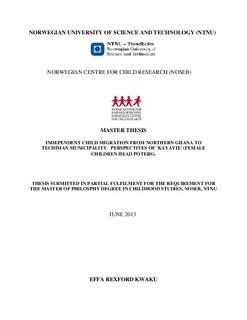| dc.description.abstract | In recent years, the north-south migration of children is on the increase and is gaining popularity in the Ghanaian media especially in Accra and Kumasi. Previous studies on child migration focused mainly on boys as well as on big cities like Accra and Kumasi. However, this research focuses on Techiman town which serves as a transit town between resource-deprived northern parts of Ghana and the southern parts where migrants are usually destined. This explores the motives of female migrant children, their decision to migrate, the mode of movement, their experiences in Techiman and the consequences of their migration.
The main theoretical perspective guiding this study is the social studies of children and childhood. The study regards the female child migrant as a social actor in the exercise of agency, the female child as both a being and becoming. A central argument in this theoretical approach is that in order to understand children and childhood, researchers have to give them a voice in matters that affect them. Therefore, the study involved children as principal informants. The research was conducted qualitatively. Data collection techniques include participant observation, focus group discussion, semi-structured interviews and migration stories.
The study has found out that poverty is the one of the major forces behind the north-south migration of female children. It also identified globalisation through the electronic media, climate change, and children’s desire to free themselves from parents and for wealth as well as other socio-cultural such as force and early marriages compel girls to migrate southwards. The study has also found out that in some instances children take decision to migrate independently. However, parents, relatives and peers also play critical role in children’s decision to migrate.
The study documents the various consequences of migration on female children. These include the difficulties associated with their work, accommodation and health challenges. It concludes that migration of female children have both positive and negative consequences like work related risk,shelter related risk and reproductive health risk. I recommend that strategies for poverty alleviation such as the National Health Insurance Scheme should be strengthened. | nb_NO |
